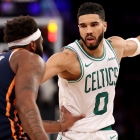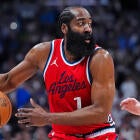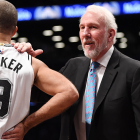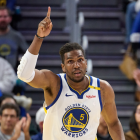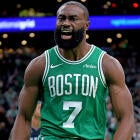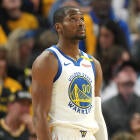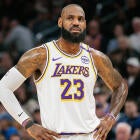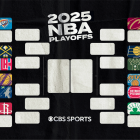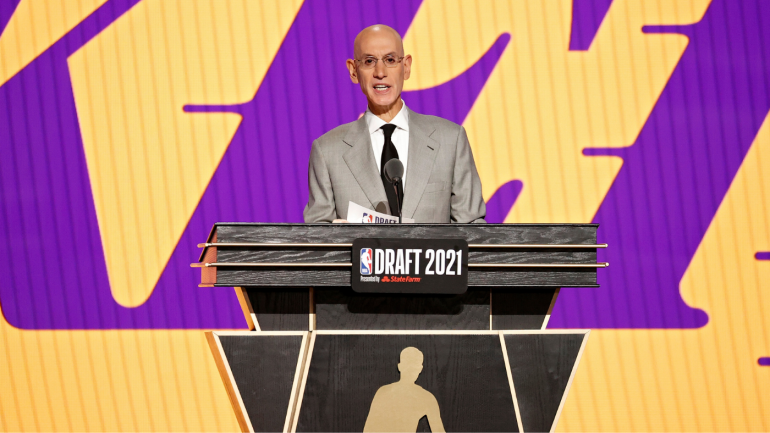
The single most influential figure involved in the 2022 NBA trade deadline died over 14 years before the season began. Ted Stepien owned the Cleveland Cavaliers for roughly three years in the 1980s. In that time, he traded away five top-11 draft picks. Four of them went to the Dallas Mavericks, essentially building their late-80's contender. The fifth was the No. 1 overall pick in 1982. That went to the defending champion Los Angeles Lakers, who selected James Worthy and grew into a dynasty. Needless to say, this was an arrangement the NBA did not deem tenable.
When he sold the Cavaliers in 1983, the NBA created what is now referred to as the "Stepien Rule," which prevents teams from being without first-round picks in consecutive drafts. At the time, this was a relatively minor tweak meant to curb the madness of desperate owners like Stepien. The vast majority of teams simply didn't trade first-round picks all that often. Needless to say, that hasn't lasted.
In the past few years alone, the Lakers, Bucks, Clippers and Nets have traded several first-round picks to acquire superstars. Chicago and Utah have given up multiple first-rounders in a series of deals that have left them in a similar position. Countless others are out at least one first-round pick, but that pesky Stepien Rule is going to make it significantly harder for them to trade others because of the protections they put on the pick they sent out. NBA front offices have grown far more sophisticated in the decades since Stepien's ouster.
The result is one of the most complicated trade markets in NBA history. Essentially every championship contender is severely limited in the amount of draft capital it can trade for immediate upgrades. Why is that? Let's take a brief look at the rules governing first-round picks in trades.
- Teams can only trade draft picks (in either round) up to seven years in the future. It therefore behooves acquiring teams to ensure that any picks acquired six or seven years down the line are either unprotected or lightly protected because there are simply fewer chances for those picks to convey if they aren't.
- The Stepien Rule prevents teams from being without first-round picks in consecutive years. The catch is that they need not control their own first-round pick. Any first-rounder satisfies the terms of the Stepien Rule.
- Here's where things get trickier. A team must be guaranteed to own a pick every other year. As far as the Stepien Rule is concerned, if a team might not own a first-round pick in a given season, it doesn't own a pick in that season. This matters because the overwhelming majority of first-round picks traded nowadays carry multi-year protections. Let's use Portland as an example here. The Blazers owe only a single first-round pick to Chicago. However, that pick has protections that stretch from 2022 through 2028. That means that they cannot trade a single first-round pick between now and then because they might owe a pick in any one of those seasons.
- There are two workarounds to the above. The first would be removing the protections from an owed pick, which is not only risky, but requires the consent of the team that owns that pick. The second is by trading picks without a designated year. Typically, the way this works is for the trading team to agree to send out a first-round pick two years after the original pick or picks that it owes elsewhere convey. Put more simply, it essentially means agreeing in advance to give up their next allowable pick even if they don't technically know when that pick will come. The downside risk here is that if the protections on those previously owed picks prevent them from conveying long enough, the acquiring team can be left with nothing. This notably occurred in 2017. At the time, the Lakers owed two future first-round picks, the second of which was meant for Orlando. The problem was that the first was top-three protected… but came in at No. 2 overall three years in a row. The Orlando pick therefore expired because it would have needed to convey more than seven years after the original deal.
- The Stepien Rule only works moving forward. Whether a team had a pick in the previous season is irrelevant.
Yes, all of this is quite complicated. I'm going to make it simpler. Below, I'm going to cover which first-round picks all 30 NBA teams can and cannot trade at the Feb. 10 deadline. If you're interested in information on specific picks or protections, RealGM has a frequently-updated list of every owed draft pick in the NBA on which much of this story is based.
Completely unencumbered
The following teams do not owe a single first-round pick to any other team, nor do they own any first-round picks from other teams, except for the Hawks, who own a pick that is almost certain not to convey, so we're sticking them in this category for the sake of convenience:
- Atlanta Hawks
- Boston Celtics
- Cleveland Cavaliers
- Indiana Pacers
- Minnesota Timberwolves
- Sacramento Kings
- Toronto Raptors
For trade purposes, we'll call these teams the blank slates. They own their own picks. That's it. Therefore, functionally speaking, any of them could trade as many as four first-round picks at the deadline: their picks in 2022, 2024, 2026 and 2028. They could also offer the right to swap picks with them in any year that they retain a first-round pick. Simple enough, right? Things are about to get more complicated.
Owes first-round picks, but are not Stepien-locked
Two teams are in a rather unusual position. They owe first-round picks to other teams through trades, but because they are also receiving first-round picks in other deals, they have no functional Stepien Rule restrictions.
- Houston Rockets. The Rockets owe their first-round pick to the Thunder in 2024 and 2026. However, they will also receive first-round picks from the Nets in both of those years, and while the picks they are sending Oklahoma City are protected (1-4 in both cases), neither extends for multiple years. If those picks do not convey, they revert to second-rounders. Therefore, the Rockets have at least one first-round pick in every tradable season, and can essentially operate freely.
- Oklahoma City Thunder. It is laughable that the Thunder are in this category, but if we're being absolutely technical, they owe their lottery-protected first-round pick to the Atlanta Hawks. That pick almost certainly is not going to convey, and will therefore convert into two second-round picks, but if the Thunder were a normal team, they'd still have some Stepien issues because of that owed pick. Of course, the Thunder are not a normal team. They own 17 first-round picks in the next seven drafts. That includes an unprotected 2022 pick from the Clippers that gives them complete freedom in trades. The Thunder are still in the business of accumulating picks, not dealing them.
Owes first-round picks, are partially Stepien-locked
The following teams owe first-round picks to other teams that in some way limit their ability to trade future first-round picks.
- Brooklyn Nets. Brooklyn's situation is very straightforward. The Nets owe 2022, 2024 and 2026 picks to the Rockets. They can therefore trade their 2028 first-round pick. They also owe swap rights to the Rockets in 2023, 2025 and 2027.
- Charlotte Hornets. The Hornets owe their 2022 pick to the Knicks, but it has protections that could take it to 2025. That means that the Hornets, at this moment, can only trade either their 2027 or 2028 first-rounder. As that pick is protected 1-18 this season, it is unlikely to convey at this moment, but the protections lighten to 1-16 next season and 1-14 next season, meaning it will probably go to New York in the next few years. That makes the Hornets a "next allowable" candidate should they choose to pursue an upgrade. The 2022 pick they own from New Orleans doesn't help because it is protected.
- Chicago Bulls. The Bulls owe the Magic their 2023 pick from the Nikola Vucevic trade. It is protected 1-4 and again protected 1-3 in 2024. Two years after that pick conveys, they owe the Spurs a first-rounder from the DeMar DeRozan trade. That pick is protected for three full years and might not resolve until 2028. Therefore, the Bulls are not guaranteed a first-round pick in any season between 2023 and 2028, preventing them from trading any of their own first-round picks in the allowable seven-year period. However, the future first-round pick the Bulls own from the Blazers is tradable, as Chicago is not relying on it to fill any sort of Stepien void. That pick is lottery-protected every year between now and 2028, so in practice, it will convey the first time the Blazers make the playoffs in that span.
- Dallas Mavericks. Dallas owes its 2023 first-round pick to the Knicks, which not only prevents the Mavericks from trading their 2022 pick, but any first-rounders until either 2027 or 2028. The pick owed to New York has protections that last through 2025.
- Golden State Warriors. The Warriors owe a 2024 first-round pick to Memphis that is protected through 2025, but becomes unprotected in 2026. They therefore have two tradable first-round picks: 2022 and 2028.
- Los Angeles Clippers. The Clippers gave the Thunder their first-round picks in 2022, 2024 and 2026. Therefore, their only tradable first-round pick is in 2028.
- Los Angeles Lakers. The Lakers are in a unique position. Their 2022 pick will go to either Memphis or New Orleans, depending on where it lands, but the real pickle comes in the next pick they traded in the Anthony Davis deal. That pick is scheduled to convey in 2024, but if the Pelicans aren't satisfied with where it lands, they can choose to defer that commitment to 2025. As far as the Stepien Rule is concerned, this means that the Lakers don't have picks in either 2024 or 2025, so they are limited to trading only one more first-round pick, in either 2027 or 2028.
- Miami Heat. The 2023 pick Miami owes to Oklahoma City has protections that might delay its conveyance until 2026. That means, at the moment, that the Heat are limited to offering their 2028 first-round pick in a trade.
- New Orleans Pelicans. The Pelicans might have two first-round picks in 2022… or they might have none. Technically, that prevents them from trading their 2023 pick. This shouldn't be a deterrent for the Pelicans should they need draft capital, though. New Orleans owns three extra picks from the Lakers and Bucks between 2024 and 2027.
- Philadelphia 76ers. The 76ers owe their 2025 pick to the Thunder, and it comes with protections through 2027. That prevents them from trading any of their picks from 2024 on, but their 2022 or 2023 pick is fair game in a deadline deal.
- Phoenix Suns. The Suns can't trade a pick until 2027 because the first-round pick they sent the Thunder for Chris Paul is not guaranteed to convey until 2025. However, Phoenix is a prime candidate for "next allowable" language because their pick is almost certain to go to the Thunder in June. It is protected only 1-12 for this season. The Suns are 30-9. They aren't picking in the top 12. If they offered a first-round pick to another team in a trade, that team could be relatively certain that Phoenix's obligation to Oklahoma City wouldn't stand in their way. Therefore, if Phoenix wanted to get particularly aggressive, it could essentially offer unprotected picks in 2024, 2026 and 2028 using "next allowable" language.
- Utah Jazz. At this moment, the two first-round picks Utah owes to Memphis and Oklahoma City, respectively, might not convey until 2026. That would Stepien-lock the Jazz until 2028. However. It should be noted that the top-6 protection on their 2022 pick is basically irrelevant at this stage because of how well Utah has played. They will send their pick this year to the Grizzlies, so if they needed to unlock a second first-rounder for trade (their 2026 pick), they could negotiate with the Thunder to remove the protections on the 2024 pick owed to Oklahoma City. I wouldn't deem this all that likely, though, as removing protections on a pick two years away is extremely risky.
- Washington Wizards. The Wizards are still out one first-round pick from their 2020 John Wall-Russell Westbrook deal, and that pick could convey any time between 2023 and 2026 due to its protections. That leaves only their 2028 pick as a possible trade chip for the time being.
Owes first-round picks, are fully Stepien-locked
The following teams cannot technically trade a first-round pick. In some cases, though, they can offer teams a possible first-round pick through the "next allowable" language. However, any acquiring team would have to accept that pick with the risk that it might never convey.
- Denver Nuggets. Denver owes its 2023 first-round pick to the Thunder, but it has protections that last until 2025. Two years after that pick conveys, it owes another one to Orlando with light protections. All told, its obligation to the Magic might not be fulfilled until 2027. That prevents the Nuggets from trading any more first-round picks for the moment, but Denver is good enough that teams might be comfortable with a "next allowable" arrangement that gets them an unprotected pick in 2027 or 2028. The pick the Nuggets owe the Thunder is lottery-protected and the one they owe the Magic is top-five protected. Denver will almost certainly be in the playoffs every year moving forward, and something would have to go horribly wrong for them to be in the top five between 2025 and 2027.
- Detroit Pistons. Detroit owes only a single first-round pick, the result of their trade for the pick that became Isaiah Stewart in the 2020, but that pick is protected every year between now and 2027. Therefore, the Pistons cannot trade any of their first-round picks this season.
- Milwaukee Bucks. The Bucks went all in last season. Their 2023, 2025 and 2027 picks are all gone, but they helped Milwaukee land Jrue Holiday and P.J. Tucker. Even if those trades prevent them from trading any new first-round picks this season, those were picks well spent with the Bucks winning the championship last season.
- Portland Trail Blazers. Portland's situation is straightforward. The Blazers owe their 2022 pick to the Bulls… but it is lottery-protected every year between now and 2028. It is therefore possible that they could be without a first-round pick in any of those seasons, meaning that despite owing only a single pick, the Blazers cannot trade any first-round picks this season.
Only receives first-round picks, can trade freely
The following teams not only control all of their own first-round picks, but have at least one coming to them from another team as well. These teams are, by and large, the most powerful on the trade market.
- Memphis Grizzlies. The Grizzlies will receive a 2022 pick from the Lakers (so long as it falls outside of the top 10), a pick from the Jazz that could convey any team between 2022 and 2024 before becoming two second-round picks if it does not, and a pick from the Warriors that will convey between 2024 and 2026, as it becomes unprotected in 2026 if the Grizzlies have not yet received it.
- New York Knicks. The Knicks will receive a first-round pick from the Hornets that could convey between 2022 and 2025, but converts into two second-round picks if it falls in the protected range in all four seasons, and a first-round pick from the Mavericks that could convey between 2023 and 2025, but also converts to a second-round pick if it falls in the protected range in all three seasons.
- Orlando Magic. Orlando will receive a first-round pick from Chicago that could convey in either 2023 or 2024, but converts to two second-round picks if it falls in the protected range in both of those seasons, and they will also receive a first-round pick from the Nuggets that could convey between 2025 and 2027, but if it remains in the protected range for all three seasons, Denver will send Orlando nothing.
- San Antonio Spurs. The Spurs are owed a first-round pick from Chicago that could convey any time between 2025 and 2028 depending on both the resolution of Chicago's obligation to Orlando and the protections on the pick Chicago owes to San Antonio itself. If that pick never conveys, it becomes a second-round pick.
![[object Object] Logo](https://sportshub.cbsistatic.com/i/2020/04/22/e9ceb731-8b3f-4c60-98fe-090ab66a2997/screen-shot-2020-04-22-at-11-04-56-am.png)









